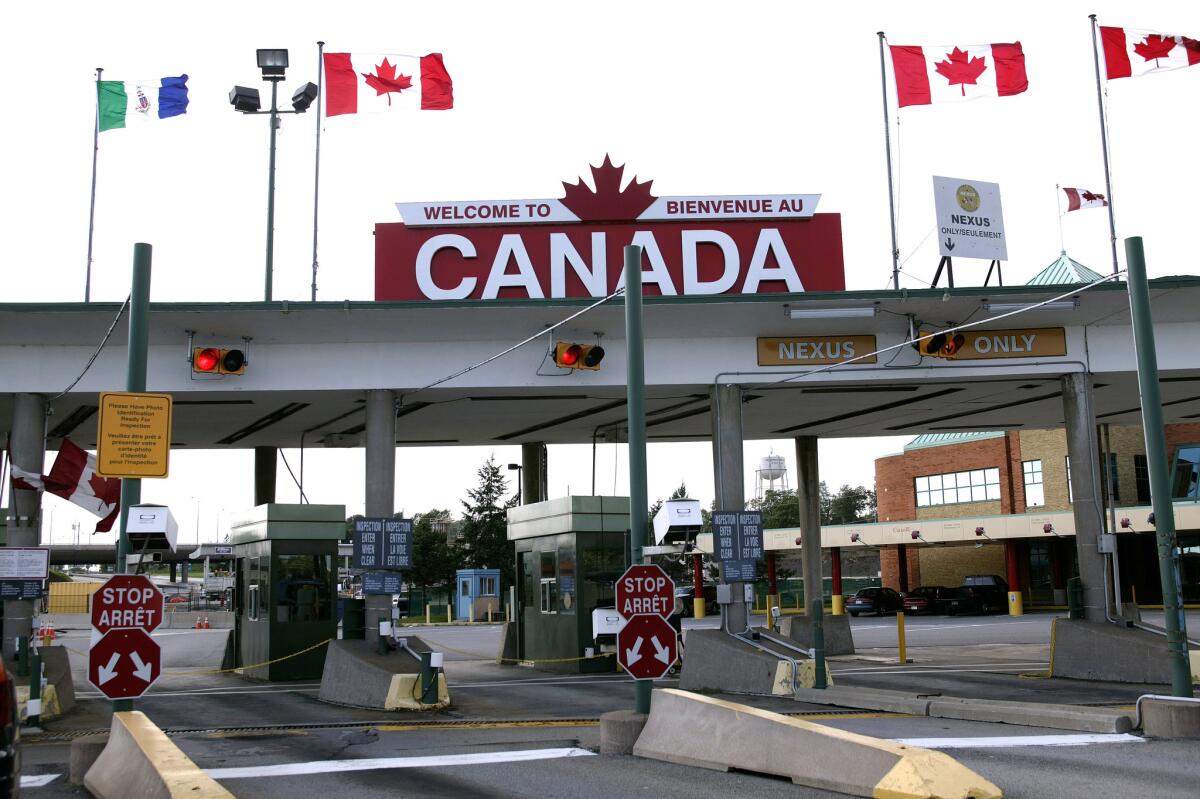Op-Ed: Canada’s sanctuary for migrants is built on a strict immigration policy

- Share via
To a lot of commentators, Canada looks like a sanctuary for progressive thinking on immigration, an exception to the nativist wave sweeping the United States and Europe.
A recent cover of the Economist put a maple leaf crown on the Statue of Liberty and proclaimed Canada “an example to the world.” Famously, on election day, the Canadian immigration website crashed because of the number of Americans reportedly considering a move to their northern neighbor as Donald Trump won the presidency. Year after year, polls show that Canadians are, by far, more open and more optimistic about immigration than the citizens in any other Western country.
But such optimism is perhaps easier to achieve in Canada than in other nations: For historical and geopolitical reasons, Canada does not have to cope with the same immigration challenges as the U.S. and Europe.
To start, Canada has pursued a much more selective immigration policy than the United States or any western European country. It accepts far more immigrants legally than most Western nations, but under a policy designed primarily to dovetail with the economic interests of the nation.
Canadians are undoubtedly more tolerant of immigration than many of their Western peers.
Since the 1960s, the country has sought to reduce instances of racial bias in its immigration policy, and it now prioritizes professional competence in a younger generation of migrants, regardless of ethnicity. In 1967, it was the first country to move to points-based admission, which other countries have adopted and refined since then: Applicants are rated according to their skills and adaptability relative to the Canadian workforce.
In consequence, Canada accepts far fewer immigrants on the basis of family ties than in the U.S., for example, and the proportion of skilled immigrants is much higher. Further, the country sets a higher education standard for immigrants than the U.S. (which is in turn more demanding than Europe). This more-selective immigration policy is likely to lead to fewer integration problems and easier access to jobs.
Canada’s selectivity is helped by its geographical position. It does not share a border with a country where wages are much lower (as the U.S. does with Mexico), and it isn’t next door to unstable regions (as Europe is to North Africa and the Middle East). The result is that few undocumented migrants move across the country’s southern border, as is the case in the U.S.; and few migrants land on its shores by boat, as in Europe.
The points system and geography also have a noticeable effect on where Canada’s immigrants come from.
Official data show that the leading countries among foreign-born residents in Canada are the United Kingdom, China and India. In the U.S., 28% are Mexicans and 24% are from other Latin American countries. In Europe, foreign-born residents originate mainly from the Muslim world (in the Netherlands, for instance, Turkey, Suriname and Morocco; in France — Algeria and Morocco). Consequently, Canada does not have to deal (at least not on the same scale) with the complex problems associated with integrating newcomers from a rural and conservative Muslim background into a highly secular environment.
Not that Canada hasn’t welcomed Muslims. Between November 2015 and November 2016, it resettled more than 35,000 Syrian refugees; most European countries have been much more reluctant to extend permanent status to these immigrants. But again, Canada can and does exert a great deal of control over the process.
Refugees accepted in Canada have been selected by the United Nations High Commissioner for Refugees. They’ve had health and criminal background screenings; their identities have been permanently registered using biometric security methods such as iris scanning. Canada accepts only whole families, single women or children. Single men, considered a possible security threat, are turned away.
In contrast, a recent study carried out by UNHCR shows that about 62% of all migrants who arrived in Europe in 2015 were men; 22% were children and only 16% were women. (A portion of these are Syrian refugees, but the EU’s inadequate screening does not allow us to estimate the number.) Of course, not all of them were accepted for permanent settlement, but these numbers show that European nations do not have the luxury to pick and choose refugees.
Canadians are undoubtedly more tolerant of immigration than many of their Western peers. The country succeeds in having both an efficient welfare state and an institutional multiculturalism that may provide an inspiring example for a globalizing world. But this success is also because of its specific geopolitical situation, and because it has one of the strictest immigration systems in the Western world.
Paul May is a lecturer in political science at Harvard University.
Follow the Opinion section on Twitter @latimesopinionand Facebook
MORE FROM OPINION
Patt Morrison Asks: Barbara Boxer is leaving the U.S. Senate but not the struggle
The media got a lot wrong this year, but the criticism has been over the top
The voters have spoken on marijuana. Trump ought to listen.
More to Read
A cure for the common opinion
Get thought-provoking perspectives with our weekly newsletter.
You may occasionally receive promotional content from the Los Angeles Times.










